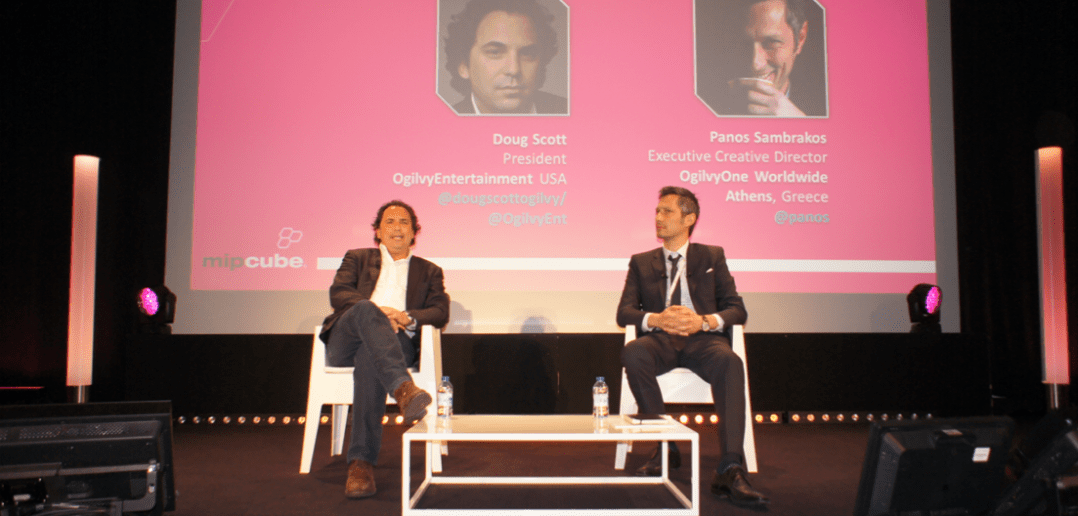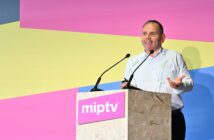Photo: OgilvyEntertainment president Doug Scott (left), executive creative director Panos Sambrakos, Ogilvy One Worldwide.
For those curious about the definition of branded content, OgilvyEntertainment president Doug Scott has an explanation: “It is not product placement. Placing your product in the shot of someone else’s story is not branded content,” he said. “I would say it’s an original story informed by the brand’s brief or positioning.” Red Bull, he said, is a powerful branded content powerhouse.
“Not only have the advertising industry embraced branded content, but the entertainment industry has too,” Scott said. “It is very much about a collaboration.”
Alongside Panos Sambrakos of Ogilvy One, he presented four powerful examples of branded content. Ogilvy believes there are four types: digital-led, event-led, property-led and broadcast-led.
DIGITAL-LED
Coke Zero’s A Step from Zero was “driven by an insight into Coke Zero: the idea of making it possible,” said Scott. This campaign revolved around the global search, and consequential promotion, of a new dance craze. The winning dance was called the Toe Tappy.
The dance was activated across digital, events, traditional media and brought the “make it possible” message to life. It “gave rise to a movement” — something Scott went so far as to call a “cultural touchpoint” — reaching a total of 51 million people.
“The more we can create and help shape pop culture”, the more merchandising and promotion can be done around it, Scott said.
EVENT-LED
For the promotion of the Renault Twizy, an electric vehicle, Digitas, Publicis Conseil & Moxie (France) produced Plug In To Positive Energy, which revolved around a dance concert featuring David Guetta.
To tie it effectively to the electric car, they created a floor that, during the Guetta performance, enabled people to power a Twizy while dancing. It generated 14.9M impressions on Twitter alone, not to mention 100,000 test drives.
“What they really exhibited was how to take an event, and leverage that into content in a unique way: touching influencers, creating TVCs and driving earned media,” said Scott.
PROPERTY-LED
The Creators Project, the fruit of a partnership between Intel and Vice, was a project to “redefine cultural moments”. It generated 230 million video views. 1.7 million people visited the site 9 times per month in the last year. It also happens to be the MIPTV/MIPCube Brand of the Year Award winner (prize ceremony tomorrow).
BROADCAST-LED
Panos Sambrakos took the stage to present a powerful broadcast-led example. On Valentine’s Day in Greece last year, the film “Love in the End” saw the most opening night billings, selling 75% of tickets in Greece that night. It was a branded film for Lacta, a chocolate bar popular among “lovesick teens”, according to Sambrakos.
To succeed at broadcast-led branded content at this scale, it’s key to integrate your brand’s message into the movie theme; “that way your message is conveyed more effectively,” Sambrakos said.
To produce “Love in the End,” customers were invited to participate in its creation. They asked people to send in stories of unfulfilled love, promising that, on Valentine’s Day, three of them would get a happy ending.
They also considered how young Greeks consume media today. To benefit from piracy, they seeded a 20-minute film that told one of the stories and left users with a cliffhanger.
Finally, they used all available media to market it – including the chocolate’s own wrapping.
“Who would have thought a few years ago that we could make a 90-minute ad about chocolate, and that people would pay $1M to see it?” Sambrakos marveled.





1 Comment
Pingback: #SocialSkim: Ebert, Government Vines, Facebook and Millennials, Twitter CVs, Branded Blockbusters | Greatwhitemarketing